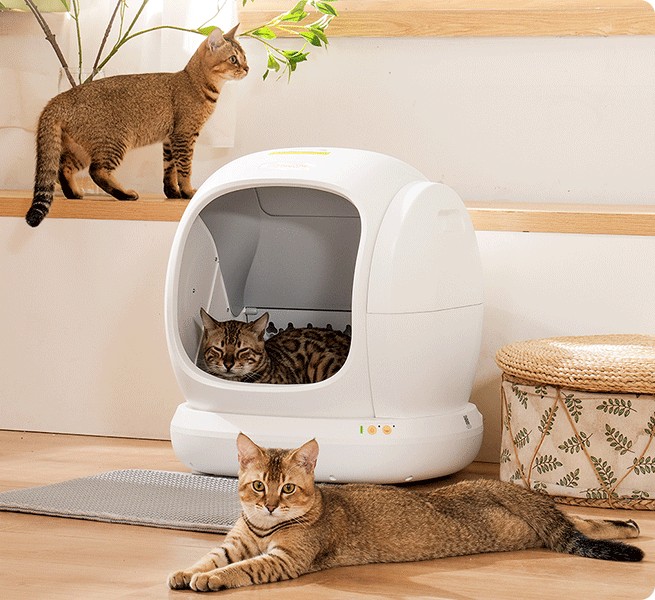Did you know that over 60% of serious feline health issues could be detected weeks earlier through proper litter box monitoring? For cat owners, the cat litter box isn’t just a maintenance chore – it’s a vital window into their pet’s wellbeing. Unfortunately, subtle changes in litter box habits often go unnoticed until serious health problems develop.
Traditional monitoring methods leave cat parents guessing, especially in multi-cat households where tracking individual habits becomes nearly impossible. Enter smart litter box technology: a revolutionary solution that transforms this daily necessity into a powerful health monitoring tool.
By combining automated cleaning with sophisticated tracking capabilities, these innovative systems not only eliminate the hassle of manual scooping but also provide invaluable insights into your cat’s health patterns. Discover how this technology is changing the game for proactive pet healthcare and making it easier than ever to keep your feline friend healthy.
The Vital Link Between Litter Habits and Cat Health
Understanding Feline Health Indicators
Changes in your cat’s litter box habits serve as crucial early warning signs of potential health issues. When cats experience urinary tract infections or developing kidney disease, they often show subtle variations in their bathroom routines before other symptoms become apparent. These changes can include increased urination frequency, spending longer time in the litter box, or producing smaller amounts more often.
Particularly in households with multiple cats, identifying which pet might be experiencing issues becomes exponentially more challenging, as traditional observation methods cannot reliably track individual cat behaviors.
Consequences of Missed Warning Signs
Studies show that delayed detection of urinary issues can lead to severe complications in up to 40% of cases, with some requiring emergency veterinary intervention. The challenge lies in distinguishing between behavioral changes caused by environmental factors versus those indicating medical concerns.
Many cat owners mistakenly attribute changes in litter box habits to stress or preference changes, potentially missing critical early indicators of serious conditions like diabetes, hyperthyroidism, or inflammatory bowel disease. When left unaddressed, these conditions can progress rapidly, leading to more complex health issues and significantly higher treatment costs.

Traditional Litter Box Limitations
Conventional litter boxes present significant challenges that can compromise both cat health monitoring and owner convenience. Manual observation requires dedicated time that most busy pet parents simply don’t have, leading to missed behavioral changes that could signal health issues. Even the most attentive owners struggle to maintain consistent monitoring schedules, especially during workdays or travel periods.
Traditional boxes also frequently fail at containing odors effectively, causing cats to avoid using them – a behavior that can mask genuine health concerns. This avoidance often leads to inappropriate elimination elsewhere in the home, creating a cycle of behavioral issues that further obscures potential medical problems.
In households with multiple cats, the situation becomes particularly problematic as it’s virtually impossible to track individual cats’ litter box habits without constant surveillance. The time-consuming nature of manual cleaning and monitoring not only affects the quality of health tracking but also impacts owners’ daily routines, often leading to less frequent maintenance than recommended for optimal cat health.
Smart Litter Box Technology Explained
Core Mechanics of Self-Cleaning Systems
Smart litter boxes employ sophisticated mechanical systems that revolutionize waste management. Leading manufacturers like Meowant utilize precision-engineered rake mechanisms or rotating drums that automatically separate waste from clean litter after each use.
The separation process typically activates through weight sensors that detect when a cat exits the box, initiating a quiet cleaning cycle that deposits waste into a sealed, odor-containing compartment. Advanced models feature specialized sifting patterns that minimize litter waste while ensuring thorough cleaning.
Health Monitoring Capabilities
The true innovation lies in the integrated health monitoring system. High-precision weight sensors can distinguish between different cats based on their unique weight profiles, creating individual usage logs for each pet.
These systems track crucial metrics including visit frequency, duration, and waste volume through sophisticated algorithms. Mobile connectivity enables real-time monitoring through user-friendly apps that display detailed analytics and send immediate alerts when unusual patterns emerge.
The technology can identify subtle changes in behavior patterns, such as increased urination frequency or extended litter box visits, often before visible symptoms appear. This data integrates seamlessly with broader pet health management systems, providing veterinarians with valuable insights for more accurate diagnoses and treatment plans.
Solving Cat Owners’ Needs with Smart Features
Effortless Maintenance Solutions
Smart litter boxes transform daily maintenance into a hands-free experience through sophisticated automation. The system performs scheduled cleaning cycles at customizable intervals, typically ranging from immediate post-use to daily deep cleans.
Advanced waste separation technology ensures thorough cleaning while minimizing litter waste, with some models achieving up to 90% litter conservation compared to traditional boxes. The sealed waste compartment employs multi-layer carbon filtration and antimicrobial treatments, effectively containing odors for weeks rather than days, making weekly emptying sufficient for most households.
Multi-Cat Health Tracking
Setting up individual cat profiles takes just minutes through a user-friendly app interface. Each cat’s unique weight signature is recorded during a brief learning period, typically 5-7 days, enabling the system to distinguish between multiple pets with 99% accuracy.
The app displays comprehensive health data through intuitive charts showing daily, weekly, and monthly patterns for each cat. Real-time alerts notify owners of significant changes, such as increased urination frequency or extended box visits. These insights integrate seamlessly with smart feeders and water fountains to create a complete picture of pet health.
The system can export detailed reports for veterinary consultations, enabling data-driven healthcare decisions. Advanced features include behavior pattern analysis that can predict potential health issues before clinical symptoms appear, allowing for preventive care interventions that could save hundreds in emergency veterinary costs.
Implementing Smart Litter Boxes: Practical Guide
Successfully transitioning to a smart litter box system requires careful planning and implementation. Start by placing the new box next to the existing one, keeping both operational for 7-10 days to allow gradual adaptation. Maintain the same litter type initially, then slowly transition to recommended varieties if needed. Position the smart box in a quiet, accessible location with adequate ventilation and clearance for automated mechanisms.
For optimal performance, establish a weekly maintenance routine: check waste compartment levels, clean sensors with a dry cloth, and verify app connectivity. When reviewing health data, set aside 5 minutes daily to scan automated alerts and 15 minutes weekly for detailed pattern analysis. Look for changes in frequency, duration, and weight measurements that deviate from your cat’s baseline.
Most smart systems work best with clumping litters between 2-4mm grain size, though premium systems can handle multiple varieties. Consider your home’s WiFi coverage, as consistent connectivity ensures uninterrupted monitoring.
For multi-cat households, maintain consistent feeding schedules during the initial learning period to help the system accurately distinguish between pets. Remember to keep the traditional box as backup during the first month, gradually reducing its cleanliness to encourage use of the new system.
The Future of Smart Feline Healthcare Monitoring
Smart litter box technology represents a transformative leap forward in feline healthcare monitoring. While traditional methods leave cat owners struggling to detect early warning signs, these innovative systems provide unprecedented insight into pet health through automated tracking and data analysis.
The combination of effortless maintenance and sophisticated health monitoring capabilities addresses the core challenges that have historically made proper litter box observation difficult, especially in multi-cat households. By providing real-time health insights and eliminating the burden of manual cleaning, smart litter boxes enable proactive rather than reactive pet healthcare.
As veterinary telemedicine and connected pet care solutions continue to evolve, these systems will become increasingly integral to comprehensive feline wellness programs. For modern cat owners seeking peace of mind about their pets’ health while simplifying daily maintenance routines, smart litter box technology offers an invaluable solution that pays dividends in both convenience and early disease detection.
The future of pet care clearly lies in such intelligent, connected solutions that empower owners to provide better, more informed care for their beloved feline companions.






